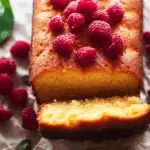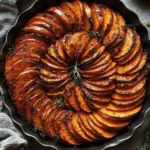This Classic Vanilla Pound Cake boasts a golden crust with a tender, buttery crumb inside. The subtle vanilla flavor shines through every bite, offering a nostalgic, comforting taste that pairs beautifully with tea or coffee. Its simplicity makes it endlessly versatile — perfect on its own or dressed up with fresh fruit, whipped cream, or a drizzle of glaze.
The smooth texture and rich flavor make it a timeless favorite for both novice bakers and seasoned pros. Whether served at a casual family gathering or a refined afternoon tea, this pound cake delivers warmth and joy with every slice. It’s a celebration of classic baking at its finest.
Full Recipe:
-
1 cup (230g) unsalted butter, softened
-
1 1/2 cups (300g) caster sugar (superfine sugar)
-
4 large eggs, room temperature
-
2 teaspoons pure vanilla extract or 1 vanilla bean, split and seeds scraped
-
2 cups (280g) plain (all-purpose) flour, sifted
-
1/2 teaspoon baking powder
-
1/4 teaspoon salt
-
1/2 cup (120ml) whole milk, warmed
Directions:
-
Preheat the oven to 325°F (160°C). Grease and line a 9×5-inch (23x13cm) loaf pan with parchment paper.
-
In a large bowl, cream the softened butter and caster sugar together using an electric mixer on medium-high speed until pale, light, and fluffy (about 5-7 minutes). This step is crucial for a tender crumb.
-
Add the eggs one at a time, beating well after each addition to fully incorporate. Stir in vanilla extract or vanilla bean seeds.
-
In a separate bowl, sift together the flour, baking powder, and salt. Gradually add the dry ingredients to the wet mixture in three batches, alternating with the warmed milk. Begin and end with the flour mixture. Mix gently after each addition until just combined—do not overmix.
-
Pour the batter into the prepared loaf pan and smooth the top with a spatula.
-
Bake for 60-70 minutes, or until a skewer inserted into the center comes out clean. If the top starts to brown too quickly, tent loosely with foil.
-
Remove from the oven and let cool in the pan for 15 minutes, then transfer to a wire rack to cool completely before slicing.
Prep Time: 15 minutes | Cooking Time: 70 minutes | Total Time: 1 hour 25 minutes
Kcal: Approximately 420 kcal per slice (based on 12 slices) | Servings: 12
Introduction to Classic Vanilla Pound Cake
The Classic Vanilla Pound Cake is one of the most beloved traditional cakes in the world of baking. Its roots trace back centuries, originally made with a pound each of butter, sugar, eggs, and flour—hence the name “pound cake.” This simple yet elegant dessert has stood the test of time due to its rich flavor, buttery texture, and versatility. Unlike more complex cakes with multiple layers and frosting, the pound cake’s charm lies in its simplicity, relying on a few quality ingredients to deliver deep flavor and moist crumb.
The vanilla flavor in this pound cake is soft and comforting, making it a perfect base for countless variations. It can be served plain, dusted with powdered sugar, paired with fresh berries, or topped with whipped cream or glaze. Its dense yet tender texture ensures every bite melts in the mouth, creating a satisfying experience for dessert lovers and casual bakers alike.
The History and Origins
Pound cakes originated in Europe in the 18th century and quickly became popular for their straightforward recipe, which required equal parts of the four main ingredients. This balanced ratio made it easy to remember and bake without complex measuring tools. Over time, bakers adapted the recipe to include baking powder to lighten the texture and added flavorings such as vanilla extract to enhance taste.
The Classic Vanilla Pound Cake is a direct descendant of these early recipes, modernized with refined ingredients and baking techniques. The introduction of baking powder revolutionized the texture, making the cake less dense but still rich. Vanilla, often called the “queen of flavors,” was added to elevate the cake’s aroma and provide a delicate sweetness that pairs beautifully with butter.
Why This Cake Is So Popular
One of the key reasons for the pound cake’s enduring popularity is its simplicity combined with indulgence. Unlike frosted cakes that require decorating skills and multiple steps, the pound cake is straightforward to prepare, making it accessible to bakers of all levels.
Its buttery flavor is deeply satisfying, and the moist texture means it’s never dry or crumbly when baked correctly. Moreover, it stores well, making it an ideal make-ahead dessert that can be enjoyed over several days without losing its freshness.
Additionally, the vanilla flavor is universally loved and neutral enough to complement a wide range of toppings and accompaniments, from fruit compotes to savory cheeses. This versatility makes it a staple for celebrations, tea times, and everyday desserts.
The Science Behind the Texture
The key to the perfect pound cake texture lies in the creaming method. Creaming softened butter with sugar incorporates air into the mixture, creating tiny bubbles that expand during baking. This process helps the cake rise and develop a tender crumb rather than becoming dense and heavy.
Using room temperature eggs ensures better emulsification and smoother batter, which results in an even texture. Alternating dry ingredients with warm milk also helps maintain the batter’s moisture and prevents overmixing, which could otherwise lead to a tough cake.
Baking at a moderate temperature allows the cake to cook evenly, forming a golden crust while keeping the interior soft and moist. The balance between butter, sugar, flour, and liquid is essential to achieving the ideal texture that is neither dry nor greasy.
Tips for Baking the Perfect Pound Cake
To bake a pound cake that rivals those from bakery shelves, certain tips can help:
-
Use high-quality unsalted butter and real vanilla extract or fresh vanilla bean seeds for the best flavor.
-
Make sure all ingredients, especially butter and eggs, are at room temperature to ensure proper mixing.
-
Cream the butter and sugar thoroughly until pale and fluffy to trap air and create a light texture.
-
Sift the dry ingredients to avoid lumps and ensure an even distribution of baking powder.
-
Add the flour mixture alternately with warmed milk, mixing gently after each addition to avoid developing gluten, which can toughen the cake.
-
Use a good-quality loaf pan and line it with parchment paper to prevent sticking and help with an even bake.
-
Avoid opening the oven door frequently while baking to maintain consistent heat.
-
Let the cake cool in the pan for a short time before transferring it to a wire rack to cool completely; this prevents sogginess.
Serving Suggestions
Classic Vanilla Pound Cake is incredibly versatile when it comes to serving. You can enjoy it simply dusted with powdered sugar for a minimalist approach or serve it with accompaniments to elevate its appeal:
-
Fresh seasonal berries such as strawberries, blueberries, or raspberries complement the buttery cake perfectly.
-
A dollop of whipped cream or a scoop of vanilla ice cream makes for a luscious dessert.
-
Drizzling a warm berry compote or lemon curd adds a tangy contrast to the sweet, buttery base.
-
For an indulgent treat, drizzle with chocolate or caramel sauce.
-
Pair it with tea or coffee for an elegant afternoon snack or dessert.
Variations to Try
While the classic vanilla flavor is timeless, the pound cake recipe can be adapted to suit different tastes and occasions:
-
Add citrus zest like lemon or orange for a refreshing twist.
-
Incorporate ground nuts such as almonds or pistachios for extra texture and flavor.
-
Swirl in chocolate or fruit preserves before baking for a marbled effect.
-
Use almond or coconut extract alongside vanilla to create new flavor dimensions.
-
Add spices like cinnamon or nutmeg for a cozy, autumnal feel.
Storage and Shelf Life
One of the many advantages of the pound cake is its ability to keep well. Wrapped tightly in plastic wrap or stored in an airtight container, it can stay fresh at room temperature for up to 3 days. For longer storage, freezing is a great option; slice the cake and wrap individual pieces or the whole loaf tightly in plastic wrap and foil before freezing. Thaw at room temperature or gently warm slices before serving for a fresh-from-the-oven experience.
Proper storage ensures the cake maintains its moist texture and buttery flavor for several days, making it a practical choice for parties or meal prep.
Nutritional Insights
Although pound cake is a rich dessert, it contains wholesome ingredients like eggs, butter, and milk, which provide protein, calcium, and vitamins. However, due to its sugar and butter content, it is considered a treat and should be enjoyed in moderation.
Its dense nature means a small slice can be very satisfying, helping to curb cravings without overindulging. For those seeking lighter options, consider pairing it with fresh fruit or yogurt to add fiber and nutrients to the dessert experience.
Why Every Home Baker Should Master This Recipe
Mastering the Classic Vanilla Pound Cake is a rewarding experience that builds confidence and baking skills. It teaches the fundamentals of creaming, mixing, and balancing wet and dry ingredients — foundational techniques for countless other baked goods.
This cake’s success lies in attention to detail rather than complexity, making it an excellent recipe for beginners and experienced bakers alike. The recipe’s forgiving nature means minor mistakes won’t ruin the final product, but following best practices elevates it to perfection.
Once you have perfected this classic, it opens the door to endless creativity with variations and flavor experiments, making it a timeless staple in your baking repertoire.
Conclusion
The Classic Vanilla Pound Cake is more than just a simple dessert — it is a celebration of traditional baking, a comforting treat that brings warmth to any occasion. Its rich, buttery flavor paired with the subtle vanilla aroma creates an irresistible combination that appeals to all ages and tastes.
Its history, simplicity, and versatility make it a must-have recipe for every baker’s collection. Whether enjoyed plain or dressed up with fresh fruit, cream, or sauces, this pound cake offers a perfect balance of texture and flavor. The knowledge and skills gained from baking this cake extend beyond this recipe, empowering you to create many more delicious baked goods with confidence.
By embracing the classic pound cake, you not only honor a cherished baking tradition but also enjoy a reliable, delicious dessert that is sure to delight family and friends for years to come.






